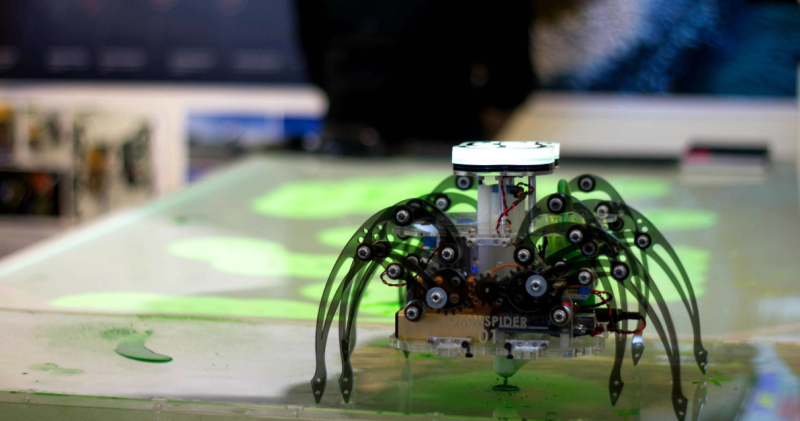Is your landscape congested with toxic waste, parched, or otherwise abandoned? The Terra Spider may be your answer to new life in otherwise barren wastelands.
Bred in the Digital Craft Lab at the California College of the Arts, the current progress demonstrates the principle of deploying multiple eight-legged drones that can drill and deploy their liquid payload, intended to “repair or maintain” the landing site.
To deliver their project, students [Manali Chitre], [Anh Vu], and [Mallory Van Ness] designed and assembled a laser-cut octopod chassis, an actuated drilling mechanism, and a liquid deployment system all from easily available stock components and raw materials. While project details are sparse, the comprehensive bill-of-materials gives us a window into the process of putting together the pieces of a Terra Spider. The kinematics for movement are actuated by servos, a Sparkfun gear-reduced motor enables drilling, and a peristaltic pump handles the payload deployment.
It’s not every day that flying robots deploy drill-wielding spider drones. Keep in mind, though, that the Terra Spider is a performance piece, a hardware-based demonstration of a bigger idea, in our case: remote coverage and sample deployments in a barren wasteland. While, this project is still a work-in-progress, the bill-of-materials and successful deployment demos both testify towards this project’s extensive development.
With the earnest intent of repairing withering environments, perhaps this project has a future as an entry into this year’s Earth-saving Hackaday Prize….
Coming soon to a galaxy near you!
















So all we need now is to discover that magic green ooze that somehow neutralizes any toxic/radioactive material? Seems like a late-nighter or two, but why not!
Just make sure it leave the turtles alone.
No secret there, its obscurum
Sounds expensive!
That thing should have wheels on it instead of legs, unless it’s climbing walls or something.
I dont think its too neutralise really more temporary seal. Even that might be hard though.
The project goal was for “maintaining” a landing site? That sounds more like weed killer dispersing robots keeping a gps, or otherwise defined area clear from vegetation, so this is a military sponsored project?
What about dispersing sunflower seeds in some image raster pattern?
> What about dispersing sunflower seeds in some image raster pattern?
Interesting idea!
Or what about guerilla-deploying some weed seeds in difficult-to-reach places?
Weed as in dandelion or weed as in pot
I love the optimism of student projects, particularly when they get to play with all the toys (cgi, quadcopters and bots) and it’s good to see architects aspiring to something other than a lifetime of off-white boxes. The whole sensor/remediation problem reminds me of one of Ambrose Bierce’s acerbic short stories: “The invention was perfect in every detail, the problems are merely basic and fundamental”.
“…that can drill and deploy their liquid payload, intended to “repair or maintain” the landing site.”
Or, attack humans, drill into their skulls, and [fill in the blank]. Some choices:
– Inject mind-altering drugs right into their brains.
– Impregnate them with alien creatures that slowly eat their hosts’ brains.
– Attach remote control devices that turn them into drones.
Any others? (c:
I’m doing a PhD in this very subject, and the work they’ve done is pretty amazing, i’m really impressed! The way they got the “spider” to walk is actually quite clever, no need to bother trying to figure out the inverse kinematics of a 3DOF leg and calibrate it. Not sure what the green stuff is though, i know they use a cleaning solution for the “alpha boxes” (I can’t remember the actual name but they look a lot like incubation chambers for new born babies, and they mess about with stuff that emits alpha radiation), it could be a representation of something similar? The point isn’t to completely clean a site though, it’s just to drop it down a classification. Those “alpha boxes” for example, if you drop one down a classification with something similar to this you go from a £90K+ cleaning cost to a few thousand. And all you have to do is spray some cleaning fluid on the perspex and give it a scrub.
I too am impressed by this project. It is a lot more sophisticated, better thought out and executed than most projects I’ve seen from engineering thesis projects.
One thought about the green ooze; I expect that the idea is to dispense some sort of polymer to seal a surface from water intrusion.
I vaguely remember there being an article on nano-tech a few months or maybe a year ago, that a professor at Lehigh university was working on dispersing iron nano particles I believe that had the ability to reduce toxic chemical emissions I. The ground….I think. I’d have to look it up again. But I do have to say if that is the case this might be a perfect way for dispersing those materials.
Walking robots are fun but I don’t see how the ones used in this project offer an advantage over wheeled robots. The step height of the robot looks very limited. I have a hard time imagining terrain which would prevent a wheeled robot from travelling while allowing these robots to safely pass.
I’d be very surprised if these walking robots were nearly as energy efficient as a wheeled robot. Are the legs just for the “cool” effect?
No, you need the blinking blue LED for the “cool” effect.
A lot of this stuff is very cool but utterly crippled by the lack of any real battery storage for the size desired.
[insert WALL·E reference here]